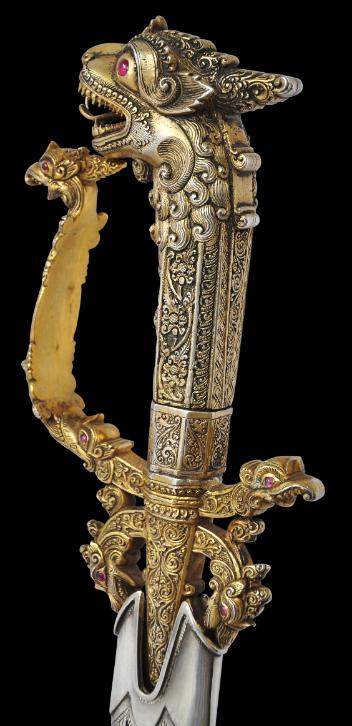
Sri Lankan Kastane/Kasthane Sword
Silver & Gilt Kasthane Sword set with Red Stones
Sri Lanka
19th century
length: 57cm, weight: 913g
The kasthane is unique to Sri Lanka. It is a dress sword that was popular in both the central Kandy Kingdom and the low, coastal areas. Kasthanes found their way to Europe and elsewhere in the seventeenth and later centuries as highly decorative curios. Sir Alexander Popham, an English seventeenth century military figure, was painted in his equestrian portrait wearing a kasthane.
This especially fine kasthane has a gilded silver pommel chiselled as a typical simha (lion) head with a prominent crest made up of an entwined liya-pata motif. A narrow, gilded pala-peti design is around the mouth. The gaping mouth has a prominent projecting tongue that points upwards and fine rows of pointed teeth. The nostrils on the snout are formed by a characteristic ‘S’ scroll. The eyes are large and distinct and comprise red stone cabochon. The ears are prominent and in leaf form.
The simha’s main comprises a series of semi-circular whirls on top and a spectacular array of whirls about the neck. The grip is almost octagonal; the ventral surface has decorated finger grooves. It is also embossed with columns of liya pata.
The narrow crossguard has two serapendiya head quillon finials. An ‘S’-shaped knuckle guard issues from the mouth one and this guard terminates in a serapendiya head with a flat, gilded, floral scroll that emits from its mouth and which does not quite join with its neck. The outward face of the knuckle guard is further decorated with a kirtimukha face amid scrolled foliage. A pair of finger-rings which also terminate with serapendiya heads are joined at their backs to the two quillons. The four serapendiya heads associated with the crossguard each have pairs of inset red stone eyes.
The ricasso at the root of the blade is encased in gilded silver sheet engraved with a scrolling motif. The langet is chased with pala-peti scrolling.
The blade, of steel, is single edged and curved. It finishes with a point. It has a fuller that runs the length of the blade. Possibly, the blade is of European manufacture; usually the blades of kasthanes are.
The scabbard is finely chased with typically Kandyan scrolling vegetal and floral patterns. The chape has a rounded scrolled end that finishhed with a silver sphere finial.
The form and motifs employed on the hilt and scabbard are similar to kasthanes in the National Museum in Colombo (illustrated in De Silva & Wickramasinghe, 2006).
References
Caravana, J. et al, Rites of Power: Oriental Weapons: Collection of Jorge Caravana, Caleidoscopio, 2010.
Coomaraswamy, A.K., Mediaeval Sinhalese Art, Pantheon Books, 1956 reprint of the 1908 edition.
De Silva, P.H.D.H & S. Wickramasinghe, Ancient Swords, Daggers & Knives in Sri Lankan Museums, Sri Lanka National Museums, 2006.
Weereratne, N., Visions of an Island: Rare works from Sri Lanka in the Christopher Ondaatje Collection, Harper Collins, 1999.
Provenance
UK art market
Inventory no.: 1407
SOLD






